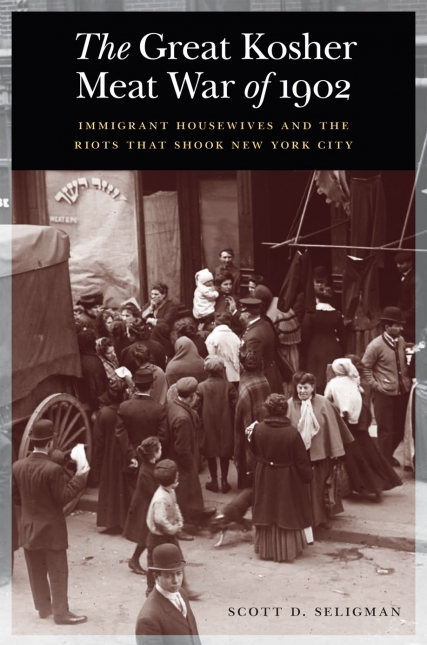The Great Kosher Meat War of 1902: Immigrant Housewives and the Riots that Shook New York City
- By Scott D. Seligman
- Potomac Books
- 312 pp.
- Reviewed by Mike Maggio
- February 11, 2021
A little-known story of poor Jewish women uniting to demand fairly priced fleishig.

When you think of the events that helped shape the early 1900s, you might conjure up images of immigrants arriving in New York City from Europe (Italy, Ireland, Russia, etc.), mostly poor, mostly illiterate, all coming through Ellis Island and ending up in tenements in Brooklyn, the Bronx, and the Lower East Side.
You might also think of labor unions (and the socialists and communists whose influence on the labor struggle was significant) and skirmishes outside sweatshops and other industrial venues where immigrants and others were abused. And you might think of men such as Andrew Carnegie, Nelson Rockefeller, and J.P. Morgan, all major forces in industrialization who helped shape a growing American economy.
But the one thing you might not think about — indeed, might not even know about — is the meat riots that once took place in Manhattan.
Led by Jewish immigrant women, many of whom had never done any community organizing before, the kosher meat uprising was a revolt against rising prices engineered by the Big Six meat conglomerates of the day: Swift, Hammond, Cudahy, Armour, Nelson Morris, and Schwarzschild & Sulzberger.
By banding together in the form of a trust, these six, located mainly in the Midwest, conspired to raise the price of meat by secretly working together to control supply and by buying up interests in railroads, the main source of meat distribution at the time. Against this formidable force stood the immigrant women.
Scott Seligman’s The Great Kosher Meat War of 1902 documents the events that led up to the riots that overtook Lower Manhattan and that would eventually spread to other cities, including Philadelphia, Cleveland, and Boston.
Backed up by detailed research (including contemporaneous newspaper articles and prints and photographs from the Library of Congress), Seligman walks the reader through the details of the kosher meat industry, as well as through the reasons why a group of ordinary, conservative housewives would rise up to lead a movement.
As it turns out, however, the battlelines were not so easily defined. While it was the Big Six who were the real villains of the story, the women — led by Sarah Edelson, a Russian immigrant, and Caroline Schatzberg, who hailed from Romania — initially aimed their anger at their local butchers, who, as a result of the increase in wholesale meat costs, had to raise their own prices in order to survive.
Despite having no training, Edelson and Schatzberg used tactics familiar to community organizers. Going door to door to raise awareness, they organized meetings and convinced their neighbors to band together in a boycott. Standing outside butcher shops, they would first try to persuade customers not to buy anything. When persuasion wasn’t enough, they resorted to other tactics, including accosting those who would not comply, grabbing the meat they had purchased, and dousing it with kerosene.
Butcher shops became scenes of mayhem — storefronts were shattered, inventory was destroyed, and many shops were demolished. Soon, the protests numbered in the thousands, and some of those who participated in the boycotts, mostly women, were beaten and jailed.
Eventually, the movement merged with the labor unions, a logical choice since unions were adept at organizing. The downside, however, was that a movement begun and led by women (at a time when female organizers were unheard of) was eventually taken over by men.
The question arises as to why the protests were confined to just kosher meat when the price of all meat was rising. In part, it was because kosher meat was already pricier. Seligman describes in great detail the complex rules of kosher meat production, including its labor-intensive slaughtering method (a warning for the faint of heart) and the strict, Talmud-dictated timeline from slaughter to sale.
The author’s lively prose brings this part of American history alive, and the book, at times, reads almost like a novel, as in this scene from protests in Boston:
“For eight hours that afternoon and evening, a mob of about a hundred who had formed an alliance against Samuel Solomont & Son, the city’s principal kosher meat wholesaler, besieged the stores of several noncooperating butchers, pelting them with eggs, vegetables, and stones. A few gunshots were also fired in the air…pretty soon an army of Jewish women joined the fray.
“‘Vein him as he veins his meat,’ one of them cried as meat was thrown into the street and Levine [one of the Boston butchers] was assaulted.”
Seligman, whose writing has appeared in the Washington Post and the Wall Street Journal, has done a service in bringing this little-known part of American history to our attention, one which demonstrates that the convergence of activism, socialism, and unionization prevalent in the early 20th century remains a staple in protests to this day.
Mike Maggio’s newest collection of poetry, Let’s Call It Paradise, will be released by San Francisco Bay Press in early 2021.

